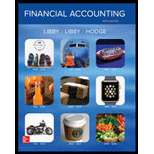
Financial Accounting
9th Edition
ISBN: 9781259222139
Author: Robert Libby, Patricia Libby, Frank Hodge Ch
Publisher: McGraw-Hill Education
expand_more
expand_more
format_list_bulleted
Concept explainers
Textbook Question
Chapter 2, Problem 3Q
Explain what the following accounting terms mean:
- a. Separate entity assumption
- b. Monetary unit assumption
- c. Going concern assumption
- d. Historical cost
Expert Solution & Answer
Want to see the full answer?
Check out a sample textbook solution
Students have asked these similar questions
I need help with this general accounting question using standard accounting techniques.
I need guidance with this general accounting problem using the right accounting principles.
general accounting
Chapter 2 Solutions
Financial Accounting
Ch. 2 - Prob. 1QCh. 2 - Define the following: a. Asset b. Current asset c....Ch. 2 - Explain what the following accounting terms mean:...Ch. 2 - Why are accounting assumptions necessary?Ch. 2 - For accounting purposes, what is an account?...Ch. 2 - What is the fundamental accounting model?Ch. 2 - Prob. 7QCh. 2 - Explain what debit and credit mean.Ch. 2 - Prob. 9QCh. 2 - Prob. 10Q
Ch. 2 - Prob. 11QCh. 2 - Prob. 12QCh. 2 - How is the current ratio computed and interpreted?Ch. 2 - Prob. 14QCh. 2 - Prob. 1MCQCh. 2 - Which of the following is not an asset? a....Ch. 2 - Total liabilities on a balance sheet at the end of...Ch. 2 - The dual effects concept can best be described as...Ch. 2 - The T-account is a tool commonly used for...Ch. 2 - Prob. 6MCQCh. 2 - The Cash T-account has a beginning balance of...Ch. 2 - Prob. 8MCQCh. 2 - At the end of a recent year, The Gap, Inc.,...Ch. 2 - Prob. 10MCQCh. 2 - Matching Definitions with Terms Match each...Ch. 2 - Matching Definitions with Terms Match each...Ch. 2 - Identifying Events as Accounting Transactions...Ch. 2 - Classifying Accounts on a Balance Sheet The...Ch. 2 - Determining Financial Statement Effects of Several...Ch. 2 - Prob. 2.6MECh. 2 - Prob. 2.7MECh. 2 - Prob. 2.8MECh. 2 - Prob. 2.9MECh. 2 - Prob. 2.10MECh. 2 - Prob. 2.11MECh. 2 - Computing and Interpreting the Current Ratio...Ch. 2 - Identifying Transactions as Investing or Financing...Ch. 2 - Matching Definitions with Terms Match each...Ch. 2 - Identifying Account Titles The following are...Ch. 2 - Classifying Accounts and Their Usual Balances As...Ch. 2 - Determining Financial Statement Effects of Several...Ch. 2 - Determining Financial Statement Effects of Several...Ch. 2 - Recording Investing and Financing Activities Refer...Ch. 2 - Prob. 2.7ECh. 2 - Recording Investing and Financing Activities...Ch. 2 - Analyzing the Effects of Transactions In...Ch. 2 - Analyzing the Effects of Transactions In...Ch. 2 - Prob. 2.11ECh. 2 - Inferring Investing and Financing Transactions and...Ch. 2 - Recording Journal Entries Nathanson Corporation...Ch. 2 - Prob. 2.14ECh. 2 - Analyzing the Effects of Transactions Using...Ch. 2 - Prob. 2.16ECh. 2 - Prob. 2.17ECh. 2 - Prob. 2.18ECh. 2 - Inferring Typical Investing and Financing...Ch. 2 - Prob. 2.20ECh. 2 - Identifying the Investing and Financing Activities...Ch. 2 - Prob. 2.22ECh. 2 - Identifying Accounts on a Classified Balance Sheet...Ch. 2 - Determining Financial Statement Effects of Various...Ch. 2 - Prob. 2.3PCh. 2 - Prob. 2.4PCh. 2 - Prob. 2.5PCh. 2 - Prob. 2.6PCh. 2 - Prob. 2.1APCh. 2 - Determining Financial Statement Effects of Various...Ch. 2 - Recording Transactions in T-Accounts, Preparing...Ch. 2 - Prob. 2.4APCh. 2 - Accounting for the Establishment of a New Business...Ch. 2 - Prob. 2.1CPCh. 2 - Prob. 2.2CPCh. 2 - Prob. 2.3CPCh. 2 - Prob. 2.4CPCh. 2 - Prob. 2.5CPCh. 2 - Prob. 2.6CPCh. 2 - Prob. 2.7CPCh. 2 - Prob. 2.8CP
Knowledge Booster
Learn more about
Need a deep-dive on the concept behind this application? Look no further. Learn more about this topic, accounting and related others by exploring similar questions and additional content below.Similar questions
- Please explain the solution to this general accounting problem with accurate explanations.arrow_forwardPlease provide the accurate answer to this general accounting problem using appropriate methods.arrow_forwardCan you explain the correct approach to solve this general accounting question?arrow_forward
arrow_back_ios
SEE MORE QUESTIONS
arrow_forward_ios
Recommended textbooks for you
 Cornerstones of Financial AccountingAccountingISBN:9781337690881Author:Jay Rich, Jeff JonesPublisher:Cengage Learning
Cornerstones of Financial AccountingAccountingISBN:9781337690881Author:Jay Rich, Jeff JonesPublisher:Cengage Learning Auditing: A Risk Based-Approach (MindTap Course L...AccountingISBN:9781337619455Author:Karla M Johnstone, Audrey A. Gramling, Larry E. RittenbergPublisher:Cengage LearningPrinciples of Accounting Volume 1AccountingISBN:9781947172685Author:OpenStaxPublisher:OpenStax College
Auditing: A Risk Based-Approach (MindTap Course L...AccountingISBN:9781337619455Author:Karla M Johnstone, Audrey A. Gramling, Larry E. RittenbergPublisher:Cengage LearningPrinciples of Accounting Volume 1AccountingISBN:9781947172685Author:OpenStaxPublisher:OpenStax College Accounting (Text Only)AccountingISBN:9781285743615Author:Carl Warren, James M. Reeve, Jonathan DuchacPublisher:Cengage Learning
Accounting (Text Only)AccountingISBN:9781285743615Author:Carl Warren, James M. Reeve, Jonathan DuchacPublisher:Cengage Learning Intermediate Accounting: Reporting And AnalysisAccountingISBN:9781337788281Author:James M. Wahlen, Jefferson P. Jones, Donald PagachPublisher:Cengage Learning
Intermediate Accounting: Reporting And AnalysisAccountingISBN:9781337788281Author:James M. Wahlen, Jefferson P. Jones, Donald PagachPublisher:Cengage Learning

Cornerstones of Financial Accounting
Accounting
ISBN:9781337690881
Author:Jay Rich, Jeff Jones
Publisher:Cengage Learning

Auditing: A Risk Based-Approach (MindTap Course L...
Accounting
ISBN:9781337619455
Author:Karla M Johnstone, Audrey A. Gramling, Larry E. Rittenberg
Publisher:Cengage Learning

Principles of Accounting Volume 1
Accounting
ISBN:9781947172685
Author:OpenStax
Publisher:OpenStax College

Accounting (Text Only)
Accounting
ISBN:9781285743615
Author:Carl Warren, James M. Reeve, Jonathan Duchac
Publisher:Cengage Learning


Intermediate Accounting: Reporting And Analysis
Accounting
ISBN:9781337788281
Author:James M. Wahlen, Jefferson P. Jones, Donald Pagach
Publisher:Cengage Learning
Cost Classifications - Managerial Accounting- Fixed Costs Variable Costs Direct & Indirect Costs; Author: Accounting Instruction, Help, & How To;https://www.youtube.com/watch?v=QQd1_gEF1yM;License: Standard Youtube License